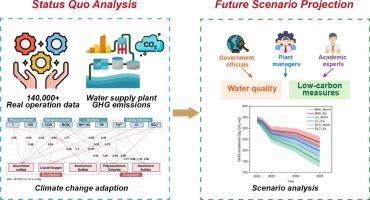Operational insights into carbon dynamics and decarbonization pathways in megacity water supply plants
IF 9.7
1区 环境科学与生态学
Q1 ENVIRONMENTAL SCIENCES
引用次数: 0
Abstract
Urban water supply systems are significant contributors to global greenhouse gas (GHG) emissions. Water supply plants in megacities, as crucial components of water supply systems, face unique challenges in achieving net-zero GHG emissions due to higher water quality and quantity requirements. However, detailed emission data and future pathways under climate change scenarios are currently lacking. In this study, we collected over 140,000 operation data entries from all 37 water supply plants in Shanghai. Based on real operational data, we have established GHG emissions inventory and projected emissions from 2023 to 2035. Future scenarios were developed through coordination with government officials, water plant managers, and academic experts. The results show that the GHG emission intensities from Shanghai’s water supply plants were 0.14 kg CO2-eq/m3 in 2021 and 0.12 kg CO2-eq/m3 in 2022. Suburban plants incur higher GHG emission intensity, while urban plants benefit from economies of scale. The dependence of GHG emission intensity on source water characteristics enables targeted mitigation strategy development. Scenario analysis shows implementation of five low-carbon measures under normal water quality conditions would reduce GHG emissions by up to 56.15 % by 2035, where smart platforms contribute the largest share (17.1 %). This study provides insights into low-carbon management policies and technologies for water supply plants in highly urbanized worldwide regions facing evolving environmental challenges.

对特大城市供水厂碳动态和脱碳途径的操作见解
城市供水系统是全球温室气体(GHG)排放的重要贡献者。特大城市的供水工厂作为供水系统的重要组成部分,由于对水质和水量的要求更高,在实现温室气体净零排放方面面临着独特的挑战。然而,目前缺乏详细的排放数据和气候变化情景下的未来路径。在本研究中,我们收集了上海所有37家自来水厂的14万多个运行数据条目。根据实际运行数据,建立了2023年至2035年的温室气体排放清单和预计排放量。通过与政府官员、水厂管理人员和学术专家的协调,制定了未来的设想。结果表明:上海市供水厂2021年和2022年温室气体排放强度分别为0.14 kg CO2-eq/m3和0.12 kg CO2-eq/m3。郊区电厂温室气体排放强度较高,而城市电厂则受益于规模经济。温室气体排放强度对水源特性的依赖使制定有针对性的减缓战略成为可能。情景分析显示,在正常水质条件下实施五项低碳措施,到2035年将减少温室气体排放高达56.15% %,其中智能平台贡献最大份额(17.1% %)。本研究为全球高度城市化地区面临不断变化的环境挑战的供水工厂提供了低碳管理政策和技术的见解。
本文章由计算机程序翻译,如有差异,请以英文原文为准。
求助全文
约1分钟内获得全文
求助全文
来源期刊

Environment International
环境科学-环境科学
CiteScore
21.90
自引率
3.40%
发文量
734
审稿时长
2.8 months
期刊介绍:
Environmental Health publishes manuscripts focusing on critical aspects of environmental and occupational medicine, including studies in toxicology and epidemiology, to illuminate the human health implications of exposure to environmental hazards. The journal adopts an open-access model and practices open peer review.
It caters to scientists and practitioners across all environmental science domains, directly or indirectly impacting human health and well-being. With a commitment to enhancing the prevention of environmentally-related health risks, Environmental Health serves as a public health journal for the community and scientists engaged in matters of public health significance concerning the environment.
 求助内容:
求助内容: 应助结果提醒方式:
应助结果提醒方式:


